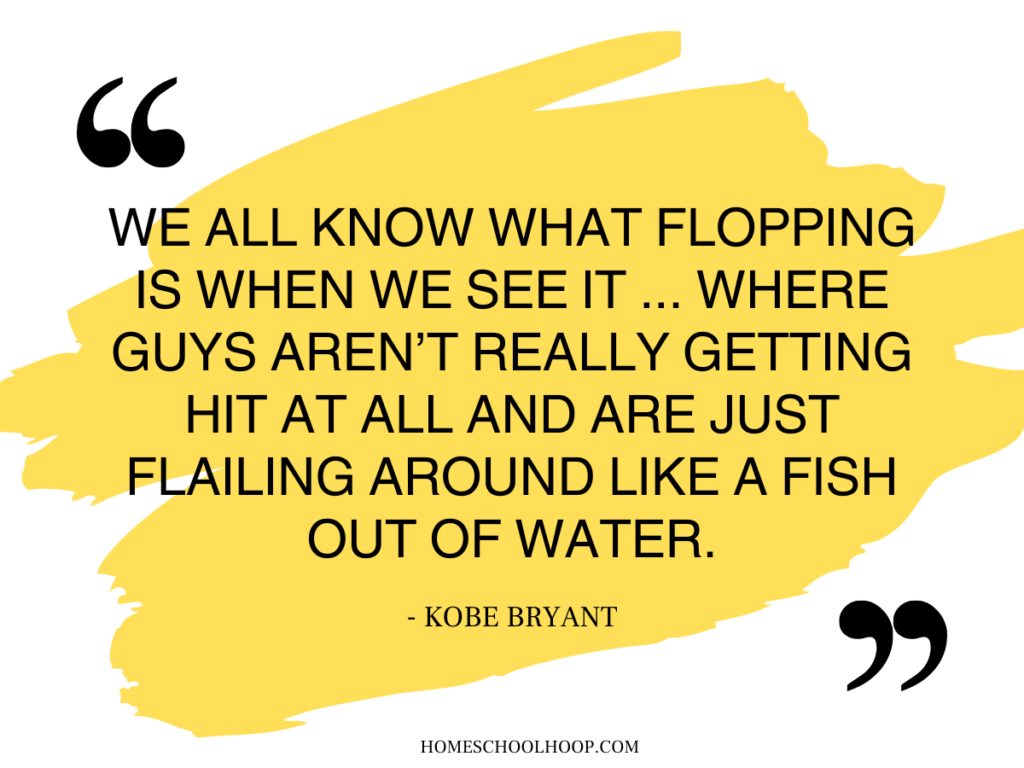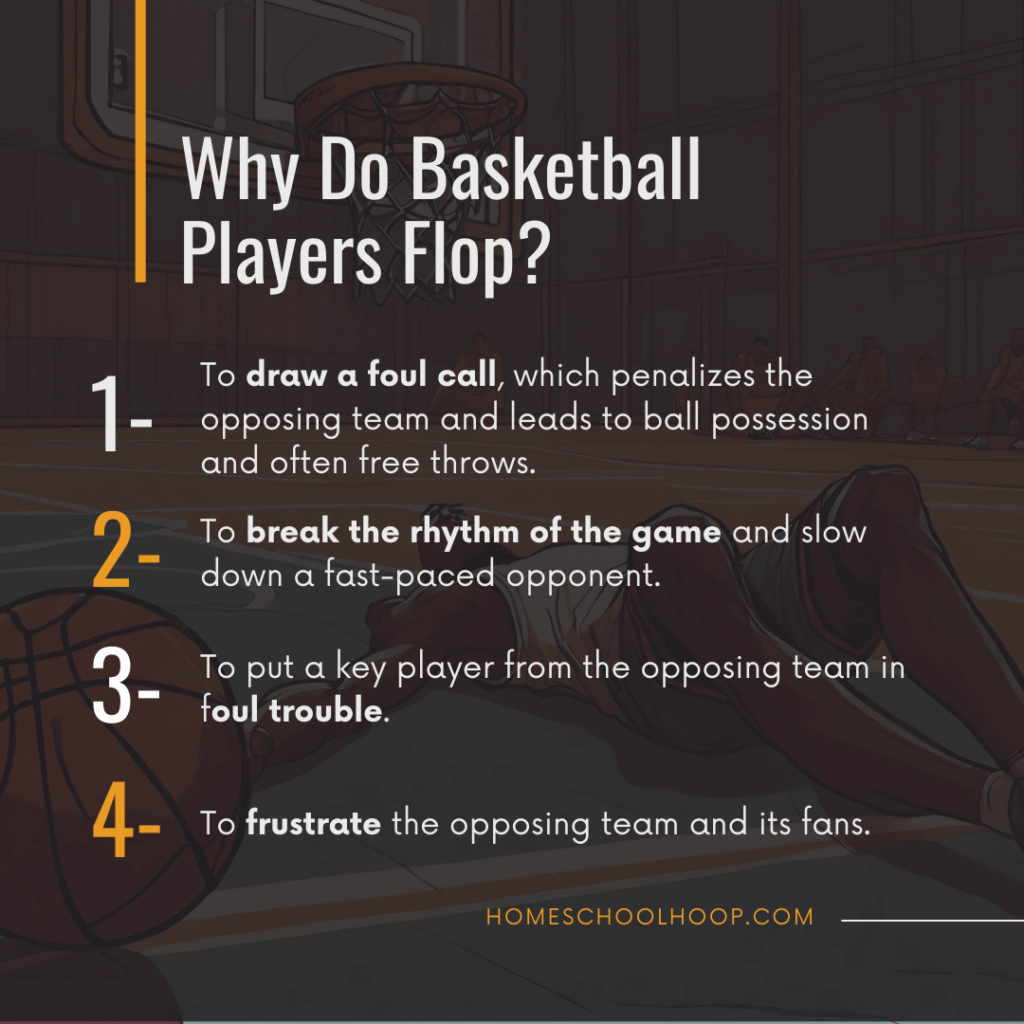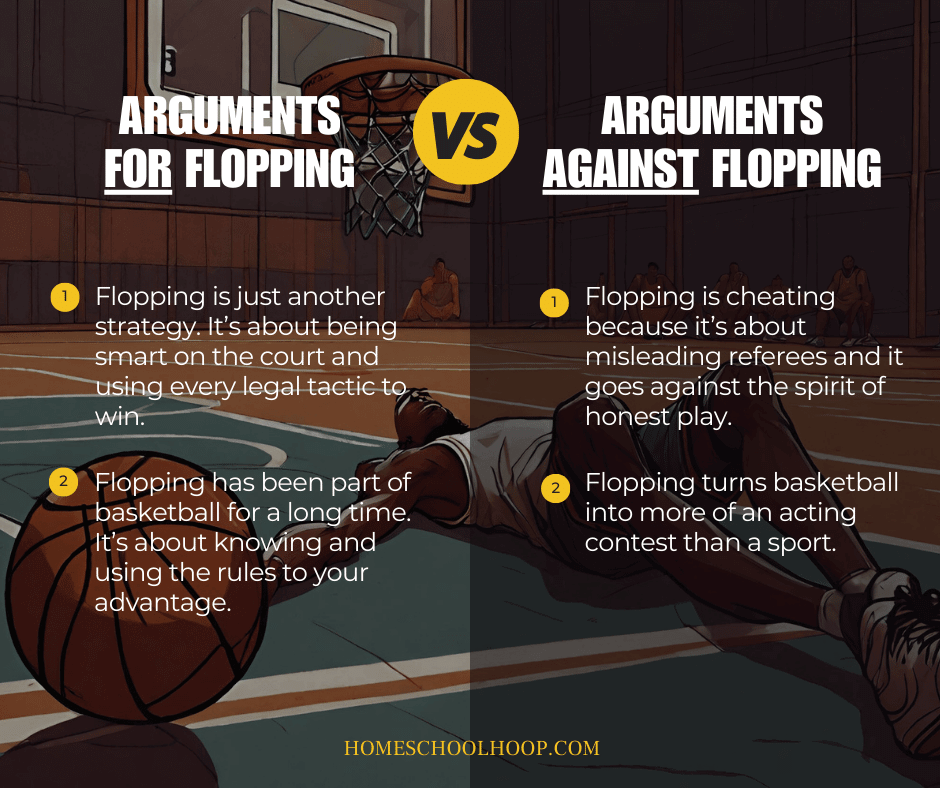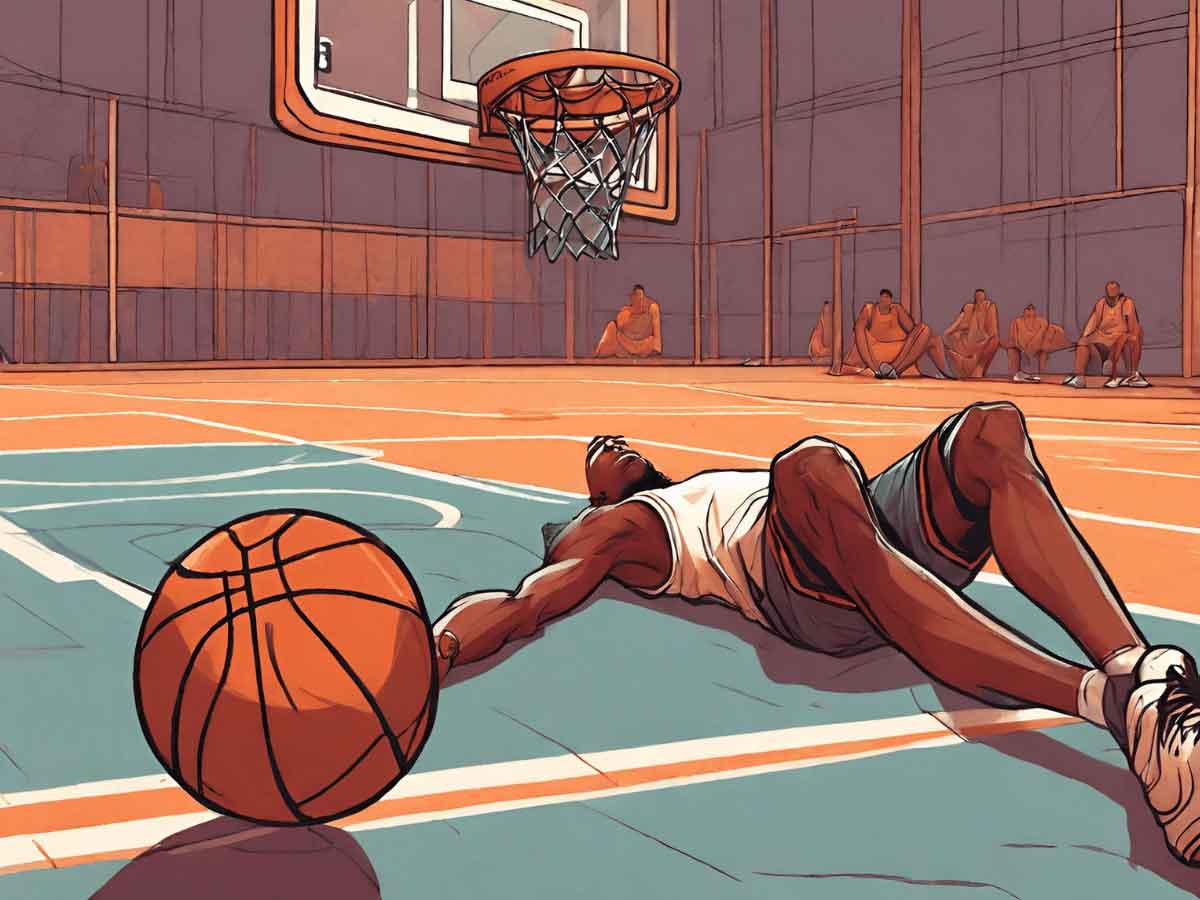Flopping in basketball is a strategy that often stirs debate among fans and players. The NBA and WNBA have even recently made rules against it because of how much it affects the game.
Let’s break down what flopping in basketball means:
Key Takeaways:
- What is Flopping in Basketball?: Imagine a basketball player falling or acting like they’re hurt more than they are. They do this to make it look like the other player committed a foul. This act is called flopping.
- Why Do Players Flop?: Players flop to trick the referees. They hope the referee will think a foul occurred and penalize the other team. This can give them an advantage in the game.
- The Debate About Flopping: Flopping is a tricky subject. Some people think it’s a smart move – a part of the game that’s not exactly against the rules but bends them. Others feel it’s not fair play and goes against the true spirit of basketball.
Flopping in basketball isn’t just about falling down; it’s a mix of game tactics, understanding the rules, and the ethical side of playing sports. In this guide, we will look closely at flopping, its history, how it’s done, and why it’s such a big topic in basketball, especially in professional leagues like the NBA and WNBA.
Understanding Flopping in Basketball
Flopping is when a player in basketball pretends to be fouled. It’s like acting in a play. The player falls or stumbles dramatically, even if the contact from the other player is slight or doesn’t happen at all. The goal? To make the referees think a foul occurred when it might not have.
Examples of Flopping:
- The Exaggerated Fall: A player might fall backward as if pushed hard, even when the contact is minimal. This can often happen under the basket or when players fight for position.
- The Dramatic Reaction: Players sometimes clutch their faces or other body parts, suggesting a hit that never really happened. This can occur when they’re closely guarded, getting hand-checked, or in a crowded area of the court.
- Drawing Contact: Players might lean into an opponent and then fall, making it seem like the opponent pushed them. This often happens on the perimeter during dribbling or shooting (with the hopes of getting an “And 1” call).
For players who do it, flopping requires skill and timing. Players must read the game, understand when to use this tactic, and make it believable. It’s about convincing the referees, not just taking a tumble.
The best floppers in the game have a keen sense of timing and theatrics. They know precisely when to use this strategy to benefit their team, often in crucial moments of the game.
However, it’s important to note that while flopping can be seen as a skill, it’s also controversial. It walks the line between clever play and unsportsmanlike conduct.

The History of Flopping in Basketball
Flopping is more prevalent than ever, but it’s not a new phenomenon. It first became noticeable in basketball games in the 1960s.
One of the first floppers in basketball history is former Boston Celtic Frank Ramsey, who admittingly made it a regular part of his game. Referred to as the “Master of Deception,” Ramsey used the technique to help his Celtics win seven championships, the most NBA rings of any other team. Still, his blatant acting was often met with boos and heckles by opposing fans.
In the 1970s and 1980s, the game was more physical, focusing less on such tactics and more on appearing tough. But, as basketball evolved, players began looking for new ways to gain an advantage. This included more frequently trying to draw fouls by exaggerating contact.
Influence of Televised Games
Everything changed when basketball games started being shown on TV in the 1980s. The players knew cameras were watching them closely. They began flopping more to get the referees and viewers to notice them. They learned that a big reaction could change the game, especially when the score was close.
Impact of International Players
In the 1990s and 2000s, more players from other countries joined the NBA. Many came from places where soccer is big, and players often fall to get a foul in soccer. These international players brought this style to basketball.
Most NBA fans recognize Serbian Vlade Divac as the player who flopped more than any other and made flopping famous. Throughout his 16-year Hall of Fame career, Divac was known for his dramatic flopping theatrics.
Notable players from Europe and South America, where soccer is dominant, seemed to use flopping with more frequency and skill. This added a new layer to the game’s strategy in the NBA and influenced how American players approached the game.
Evolution Over the Years
Over time, players got better at making their flops look real. This started discussions about what’s fair in basketball and what’s not. It even led the NBA and WNBA to create new rules against too much flopping.
Today, more players flop than don’t. Flopping is widely recognized as part of basketball’s strategy, but not everyone agrees with it.
Why Players Resort to Flopping
Players flop in basketball for one main reason: to gain a competitive edge.
Intelligent players use it strategically, knowing exactly when and how to flop to help their team. It’s not just about falling; it’s about choosing the right moment to influence the game. It’s a controversial but undeniable part of basketball strategy.
Let’s explore how this tactic can change the game.
4 Reasons Why Basketball Players Flop
- Drawing Fouls: The primary goal of flopping is to make referees think a foul has occurred. When a player flops and the referee calls a foul, such as a charge in basketball, the opposing team gets penalized. This can lead to free throws or possession of the ball, both valuable in a close game.
- Slowing Down the Game: Flopping can break the rhythm of the game. When a player falls and a foul is called, play stops. This can be useful for a team that wants to slow down a fast-paced opponent.
- Putting Opponents in Trouble: It can be a big advantage if a flop leads to a foul on a key player from the opposing team. Players with more fouls have to play more cautiously and risk being removed from the game if they accumulate too many fouls.
- Psychological Impact: Flopping can frustrate the opposing team and its fans. It can get into opponents’ heads, making them lose focus or play more aggressively, which might lead to actual fouls.

Types of Flops in Basketball
Players use different kinds of basketball flops to trick referees. Each type has its own way of being executed. Here are three common ones:
Classic Charge Flop
- What It Is: This is when a defensive player falls backward as if they’ve been pushed hard by an opponent moving forward.
- How It’s Done: The player waits for the moment when their opponent is moving towards them, then they fall down, often throwing their arms up to make it look more dramatic. This makes the referee think an offensive foul has happened.
Flail Flop
- What It Is: This involves a player exaggerating a reaction, like throwing their head back or waving their arms, to suggest that they’ve been hit.
- How It’s Done: When there is slight contact or even none, the player suddenly dramatically moves their body or head. For example, a player may set a screen in basketball for a teammate, and then flail when the defender makes contact. They do this to suggest that the contact was much more forceful than it really was.
Post-Up Flop
- What It Is: This happens in a post-up situation, where a player is backing into a defender.
- How It’s Done: The defending player will suddenly fall or stumble dramatically when the offensive player makes contact with them. The aim is to make it look like the offensive player pushed them too hard.
In this video example, Diamond Miller of the Minnesota Lynx performs a flail flop after a little contact with Brittney Griner of the Phoenix Mercury (who also happens to be the leader in WNBA dunks).
Players use these flop techniques to convince referees to call fouls in their favor. Each one requires timing and a bit of acting skill to make it look real. While effective, they are also controversial because they involve deceiving the referees.
Learn more: What is a back screen?
The Controversy Surrounding Flopping
Flopping in basketball is a hot topic. Some people defend it; most criticize it and consider it as lame as cherry picking in basketball. Let’s look at both sides of this debate.
Arguments for Flopping
- Strategic Tool: Supporters say flopping is just another strategy. It’s about being smart on the court and using every legal tactic to win.
- Part of the Game: They argue that it’s been part of basketball for a long time. Like any skill, it’s about knowing and using the rules to your advantage.
Arguments Against Flopping
- Unsportsmanlike Behavior: Critics of flopping see it as cheating. They believe it goes against the spirit of honest play.
- Ruins the Game’s Integrity: They say it turns basketball into more of an acting contest than a sport. It can also mislead referees, leading to unfair game decisions.

The ethical debate is whether flopping is a clever move or a dishonest trick. Is it okay to pretend to be fouled? Or should players always play honestly, even if it means not gaining an advantage? Let us know what you think in the comments.
Rules and Penalties for Flopping
Basketball leagues have rules against flopping to maintain the game’s integrity. Here’s how the NBA, WNBA, and NCAA handle it.
NBA
Starting in the 2023-24 season, the NBA will more strictly penalize in-game flopping in basketball games. If a player flops, they get a non-unsportsmanlike technical foul, and the other team gets one free throw. But, players won’t be ejected for flopping.
To keep the game moving, the refs won’t blow the whistle to make a flopping call. Instead, the penalty is applied at the next opportunity. Referees can call both a foul and a flopping violation on the same play.
These new rules to diminish the amount of flopping are more strict than the ones the NBA tried in 2012. With that ‘no flopping’ rule, players who flopped would first be warned, then fined $5,000 for each subsequent flop. But, the league didn’t enforce the rule.
With the new flopping rule, the NBA can still fine players for flopping after the game. Fines start at $2,000 and go up for repeat offenses.
If you were to ask fans who the biggest flopper in the NBA is, you’d probably hear names like LeBron James (currently the oldest NBA player), Chris Paul (one of the shortest NBA players), Marcus Smart, and James Harden.
Learn more: How many NBA teams are there?
WNBA
The WNBA’s anti-flopping rule, in place since the 2013 season, involves an initial warning followed by fines that increase after each additional offense. After the sixth offense, the flopping player can be suspended.
The league defines flopping as “any physical act that, upon review, reasonably appears to have been intended to cause the referees to call a foul on another player.”
WNBA player Haley Jones regularly asks other players in the league who the biggest floppers in the WNBA are when they’re guests on her Sometimes I Hoop with Haley Jones podcast. The most common names include Sophie Cunningham, DaWanna Bonner, and Tiffany Hayes.
Learn more: How many WNBA teams are there?
NCAA Men’s Basketball
NCAA Men’s Basketball has also upped the penalty for flopping in basketball games. Previously, officials would issue a warning before a technical foul.
But as of the 2022-23 season, there’s no warning. Men’s basketball officials can immediately give Class B technical fouls for flopping. The opposing team gets one free throw before a technical foul.
NCAA Women’s Basketball
The rules for flopping in NCAA Women’s Basketball aren’t as harsh as those of other leagues and organizations. However, the association did
Players who flop, which NCAA Women’s Basketball defines as “embellishing the act of incidental contact,” receive a warning for the first offense and a technical foul for any after that.
FAQs
Is it illegal to flop in basketball?
Flopping is not illegal, but it’s against the rules of basketball leagues like the NBA, WNBA, and NCAA. They have specific penalties for players caught flopping, like technical fouls or fines.
Why do NBA players flop so much?
NBA players flop to gain advantages like drawing fouls, getting free throws, or disrupting the game’s flow. It’s a strategy to influence referees’ decisions and can affect the game’s outcome.
Can you get called for flopping in basketball?
Yes, you can get called for flopping. In the NBA and NCAA, referees can give technical fouls for flopping. The NBA and WNBA also fines players for flopping in some cases.
Can you get ejected for flopping?
In the NBA, you cannot get ejected solely for flopping. Flopping results in a non-unsportsmanlike technical foul. However, accumulating technical fouls for other reasons can lead to ejection.
How can one identify a flop in a game?
A flop can often be identified when a player falls or reacts dramatically with little to no contact. It usually looks exaggerated compared to the actual contact made. Referees and replay reviews help identify flops.
Has flopping decreased in recent years?
Whether flopping has decreased is debatable. Some argue stricter rules and penalties have reduced it, while others believe it’s still a common part of the game. It varies by league and level of play.
Are there specific players known for flopping?
Yes, there are players known for their tendency to flop. Some of the biggest modern floppers in the NBA include Chris Paul, LeBron James, Marcus Smart, and James Harden. The biggest floppers in the WNBA include Sophie Cunningham, DaWanna Bonner, and Tiffany Hayes.


